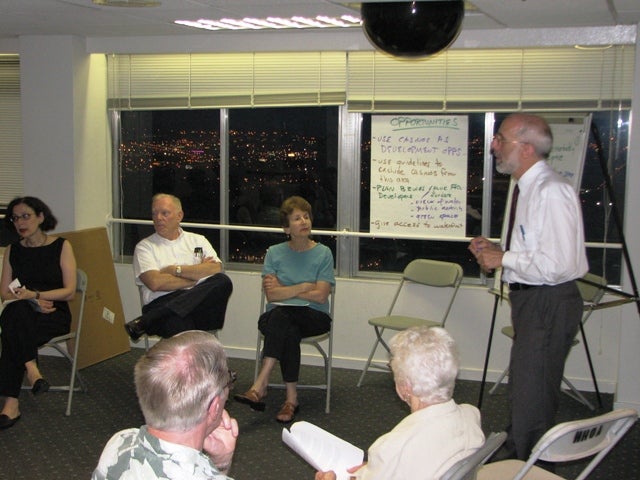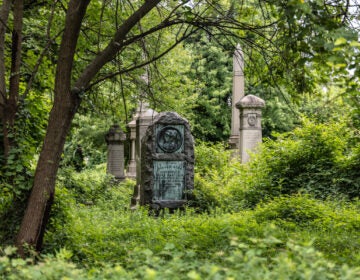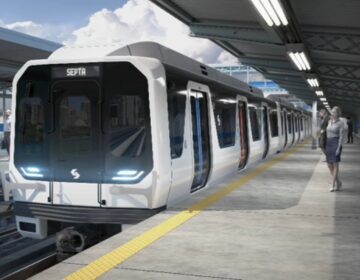What will happen in the short term?

June 19
By Alan Jaffe
For PlanPhilly
Members of the Washington Square Citizens League got their first look at the PennPraxis plans for the Delaware waterfront on Tuesday night, and they responded with concerns about how much of the vision they will see come to pass and whether casinos will be a part of it.
Larry Meehan, the president of the civic league, said the invitation to the Penn planners was partly “a reaction against casino development” and partly “a gripe about the lack of development on the waterfront.”
Many of the two dozen in attendance were senior citizens, and they wondered what short-term goals of the Central Delaware Riverfront Vision Plan will be accomplished in their lifetimes. But while they expressed some skepticism about the overall plan, most were impressed by the details and offered their own suggestions to enhance it.
Harris Steinberg, the executive director of PennPraxis, led the traveling PowerPoint presentation on the 32nd floor solarium of the Hopkinson House, which he noted was “a perfect spot” to look at the proposals for the seven-mile stretch of waterfront. From the windows of the meeting room, the group could see the neighborhoods from Center City to South Philadelphia, and the river itself from Penn’s Landing to the Walt Whitman Bridge.
Steinberg offered an overview of the project, which addresses redevelopment potential from Allegheny Avenue in the north to Oregon Avenue in the south. He explained that Mayor Street mandated the University of Pennsylvania design department to organize the process that would culminate in a plan for a revitalized waterfront.
Steinberg said the intention has always been to keep it a public process despite “a very political backdrop,” while the planners maintain “a neutral stance.”
The civic dialogue has engaged 3,000 people so far, and the discussions will determine “the blueprint for the designers,” Steinberg said. “And all this is happening in real time,” he added, with casinos possibly coming and residential development already happening. “There are many tensions along the way,” he said, “and the game’s not over yet.”
After reviewing the principles that arose from previous community meetings and the proposals that grew from design workshops – such as hiding Interstate 95 and creating an urban boulevard above it – Steinberg explained the next steps in the process. Neighborhood meetings like the one in Washington Square will continue for the next few weeks. A document containing the plan will be presented to Mayor Street “around Thanksgiving,” he said, and it will contain “build or no-build options” for the two casinos proposed on the waterfront.
There will also be “early action implementation” to realize some of the proposals in the near future. And further study and meetings with the next city administration are being initiated.
When the meeting was opened to questions, the issue of casinos came up repeatedly. And Steinberg repeated that the PennPraxis document will include two options, “with and without” the gaming halls.
Hopkinson House resident Nancy Snyder said later that a venue other than the waterfront should be sought for the casinos. “It’s too important for that,” said Snyder, a retired real estate broker. “This is scary for us.”
Scott Childress, a former chemist who also lives at Hopkinson House, noted that other large city projects had been tried and failed. “This is much more grand than the Chestnut Street walkway. Remember that?” he asked. “How are you going to bring this off?”
Steinberg said he hopes to make the argument that the investment in a new infrastructure will bring a substantial payoff for the city. By keeping the conversation as public as possible, he also hopes the city will find the political will to follow a concept that is good for everyone. “Other cities do this,” he said.
Asked about the involvement of the developers in the planning process, Steinberg said representatives of that community have been skeptical about some proposals. But if the plans become part of the city’s zoning and development rules, “they will have to comply with them.”
“That’s part of the stone we’re pushing uphill,” Steinberg said.
The question of the timeframe for implementing the plan also came up repeatedly. “That’s why we want early action,” Steinberg said. “This is an incremental, phased plan, and we will go for the low-hanging fruit. But pieces of it will have to happen over time.”
In smaller group discussions led by Harris Sokoloff of the Penn Graduate School of Education, members of the civic league added their own voices to the waterfront plan. Among the suggestions were a continuous, seven-mile walkway along the waterfront, like the Atlantic City Boardwalk. Others suggested water taxis linking points along the river, or other mass transit along the shoreline. Many of them wanted green, natural paths and stopping points, where residents and tourists could stroll or sit quietly and safely by the river.
At the end of the night, Hopkinson House resident Don Kramer said the PennPraxis plan is “an interesting approach, but it’s not a plan, it’s not prescriptive. They’re not talking about what the uses will be at this point” along the waterfront. “If it’s done haphazardly, is that good for the city?”
WHYY is your source for fact-based, in-depth journalism and information. As a nonprofit organization, we rely on financial support from readers like you. Please give today.






